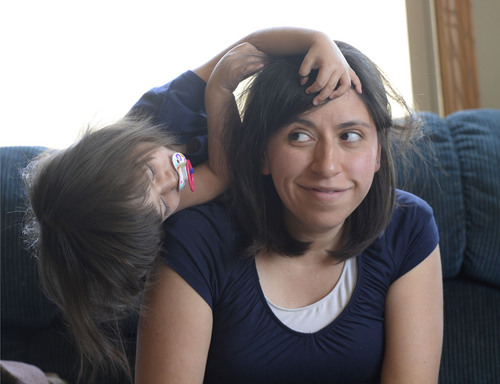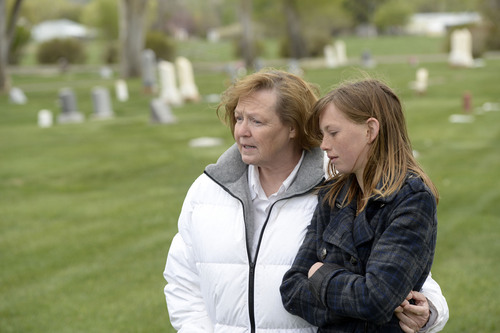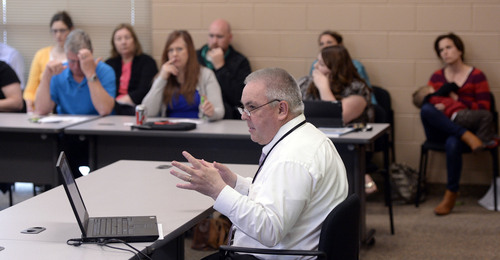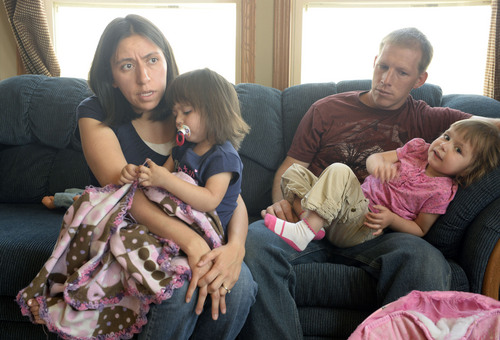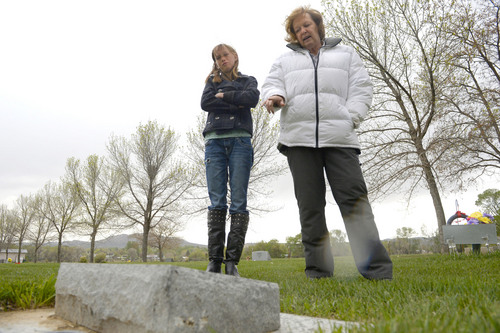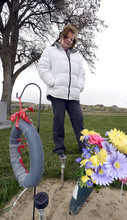This is an archived article that was published on sltrib.com in 2014, and information in the article may be outdated. It is provided only for personal research purposes and may not be reprinted.
An apparent surge in infant deaths in Vernal is raising alarms for environmental groups that question whether air pollution, largely attributable to oil and gas production, is to blame.
Families in this boom town in northeastern Utah are beginning to wonder, too.
"I've lost one child, and I don't want to lose another," said 34-year-old Caren Moon, who miscarried in November 2013. "It's a horrible thing. No matter when in the pregnancy it happens, it's a loss for the whole family."
Area health officials, with an assist from Utah epidemiologists, are examining data from birth and death certificates and Utah's fetal death registry to determine whether mothers in the tri-county Uinta Basin region have worse-than-average birth outcomes.
This is a first step, they say, before considering a costly — and, some say, impractical — environmental study.
But some in the community worry the proposed design of the initial data search is flawed.
At issue is the timeliness of the data.
The most recent year of vital statistics available is 2012 — but the suspected uptick in neonatal births happened in 2013.
"My faith in the local health system is damaged a little bit," said Donna Young, a Vernal midwife whose preliminary search of obituaries and mortuary records gave rise to the probe. "I would love to be proven wrong. But it seems the reason this study was set up the way it was is so that in six months time they can come back and say, 'There's not a problem,' and we all go on with our lives."
Young began her obituary research after a mother in her care lost a baby last May — Young's first stillbirth in 19 years of serving as a midwife. Young documented 11 instances in 2013 when a Vernal-area mother gave birth to a stillborn baby or the baby died within a few days of birth. That year there were two other infant deaths, as well as a fetus lost after more than 20 weeks' gestation.
Four of these infants were born to mothers who lived within a block of the same intersection.
Such numbers would push Vernal's neonatal death rate well above the national average, according to Utah Physicians for Healthy Environment. In 2010, it was about average.
"If they have to wait a couple of months for the 2013 statistics, that's what they ought to do, rather than leave out the year of greatest concern. Otherwise I'd be wondering what's the point," said Brian Moench, the physician group's president.
State epidemiologist Sam LeFevre said 2013 data probably won't be ready until December. "There's a 90-day reporting window, so births occurring last winter just barely arrived," he said. "Then we have to validate it, go through and look for errors."
The study's design rests with the TriCounty Health Department, which is seeking public input.
There's political pressure from some quarters to abandon the inquiry.
Multiple factors are tied to poor birth outcomes, including barriers to access to care and lifestyle choices, Rodney Anderson, a family doctor in Vernal, said at a TriCounty Health Department meeting Wednesday. "If a meth-head who has had no prenatal care shows up in my clinic, I'm not sure I want that reported in my numbers."
LeFevre believes he can statistically account for such risks, including teen pregnancies and smoking during pregnancy.
Tracing environmental causes is another matter, he said.
Vernal has a population of about 9,800 and in a city that size, you'd have to persuade every pregnant woman to agree to be studied to get the "statistical power" required, LeFevre said. "It would require taking blood, urine, hair and tissue samples and doing genetic tests. It's very invasive and very expensive, and we'd have to hire someone else to do it."
Even then, warns Seth Lyman, an air-quality specialist at Utah State University's Energy Dynamics Laboratory, the results may prove "unsatisfying."
The Uinta Basin's wintertime pollution sometimes reaches unhealthy levels. Ozone concentrations sometimes rival summertime levels in the nation's most polluted cities, according to the Utah Department of Environmental Quality.
But large cities are better testing grounds by virtue of their size, Lyman argues.
He and other researchers recently set out to document spikes in asthma hospitalizations at Vernal's Ashley Regional Medical Center around bad-air days.
"We found they're probably not related, but the data set was too small and the findings inconclusive," he said. "We know from other research that respiratory illnesses and deaths are related to poor air quality. But replicating those findings in our tiny basin is a whole other story."
Moench counters that birth studies have been done on populations in Colorado and Pennsylvania that are no bigger than Vernal, and asks, "Why can't Utah do the same?"
One study of babies born to mothers living within 10 miles of fracking wells in rural Colorado found them to be at greater risk of congenital heart defects and neural tube defects.
A study of Pennsylvania birth records from 2004 to 2011 showed infants born within a 2.5-kilometer radius of fracking are more likely to be born underweight and with health problems.
"There are other ways you can approach this. You could put air monitors at the intersection, the focal point where these deaths occurred," said Moench, noting there's currently only one monitor in the area. "This is primarily a matter of will and money, not a matter of scientific obstacles."
Locally produced research is important for informing policy decisions, Moench believes. "The health consequences out there, which go far beyond infant mortality, should be understood if oil and gas drilling is going to be the continued basis of economic viability."
Some families agree. "We're pro-oil," said Caren Moon's husband, Ben, a Gilsonite miner. "With the growing population, increased cars and traffic, you can't blame air pollution on industry emissions."
But he said, "We have to acknowledge there is a problem if we're going to make it better."
One easy fix would be for Vernal to impose emissions standards on vehicles, he said.
Caren Moon, meanwhile, is pregnant again and taking steps to protect the family. She monitors the air-quality alerts and keeps the kids inside on bad-air days. The family has installed air and water filters in their home.
Her miscarriage happened in November, early in her prior pregnancy, and might have had nothing to do with the "yucky air," she said. "We may never know. But it doesn't hurt to ask the question."
Twitter: @KStewart4Trib —
What's next?
TriCounty Health Department officials are finalizing the design of a study to determine if Uinta Basin mothers are at high risk for delivering premature, low birth-weight or stillborn babies. The study could take several months, or longer than a year, depending on how it's framed.
There are currently no plans for a follow-up inquiry, looking at possible environmental causes.



